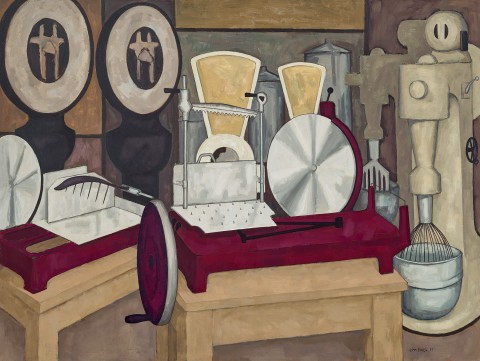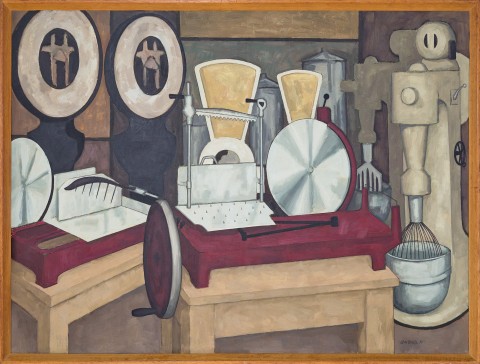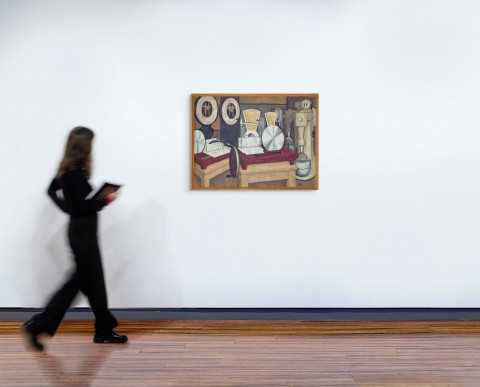The slicing machine shop, 1955
John Brack
oil on canvas
76.0 x 101.5 cm
signed and dated lower right: John Brack 55
Peter Bray Gallery, Melbourne
Australian Galleries, Melbourne (label attached verso)
Miss D Rachor, Melbourne, acquired from the above in 1958
Private collection
The Melbourne Art Exchange, Melbourne
Private collection, Melbourne, acquired from the above March 1988
John Brack, Peter Bray Gallery, Melbourne, 19 – 29 March 1956, cat. 2
Contemporary Australian Painting, Auckland City Art Gallery, Auckland, 16 February – 24 March 1957, cat. 3
Helena Rubinstein Travelling Art Scholarship Exhibition, Art Gallery of New South Wales, Sydney, 5 – 17 August 1958
A Critic's Choice - selected by Alan McCulloch, Australian Galleries, Melbourne, opened 6 March 1958, cat. 10
John Brack Retrospective, National Gallery of Victoria, Melbourne, 24 April – 9 August 2009; Art Gallery of South Australia, Adelaide, 2 October 2009 – 31 January 2010 (label attached verso)
John Brack | Melbourne | 1950s, Sotheby’s Australia, Melbourne, 11 February – 2 March 2019 (label attached verso)
Art Notes: Painter shows originality', The Age, Melbourne, 20 March 1956, p. 2
Shore, A., 'Modern Art on Show', The Argus, Melbourne, 1 December 1956, p. 44
McCulloch, A., 'Co-ordination and a satirist', Herald, 21 March 1956, p. 18
Brack on Brack, Discussion Group Art Notes, Council of Adult Education, Melbourne, 1957, p. 5
Millar, R., John Brack, Lansdowne Press, Melbourne, 1971, p. 106
Lindsay, R., John Brack: A Retrospective Exhibition, National Gallery of Victoria, Melbourne, 1987, pp. 13, 18, 117
Grishin, S., The Art of John Brack, Oxford University Press, Melbourne, 1990, vol. I, pp. 51, 88, 186, 189, vol. II, cat. o43, pp. 7, 93 (illus.)
Delaney, M., Engberg, J. & Plant, S., Melbourne, Modernity and the XVI Olympiad, Museum of Modern Art at Heide, Melbourne, 1996, p. 18
Grant, K., et. al., John Brack, National Gallery of Victoria, Melbourne, 2009, pp. 42, 43 (illus.), 215
Still Life with Slicing Machine, 1955, oil on canvas, 63.5 x 76.5 cm, private collection, sold Deutscher and Hackett, Melbourne, 13 June 2018, lot 4
Study for The slicing machine shop, c.1955, black crayon and pencil, 38.5 x 51.2 cm (sheet), National Gallery of Victoria, Melbourne
250182 Brack.jpg
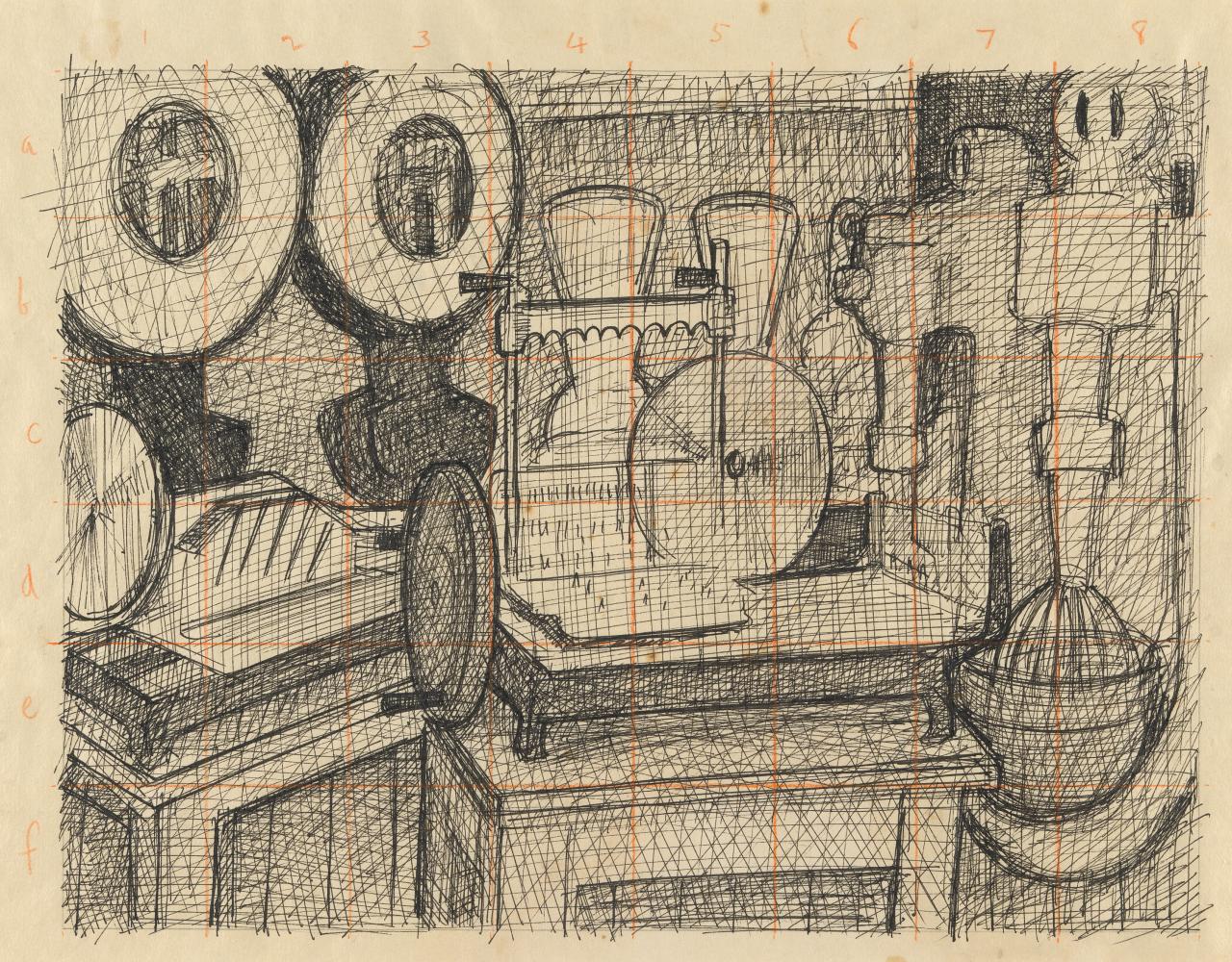
As a painter of modern life, John Brack found subjects in his immediate surroundings, the suburbs and the city of Melbourne. His best-known paintings of 1950s Australia, such as The new house, 1953 (Art Gallery of New South Wales) and Collins St, 5pm, 1955 (National Gallery of Victoria), are full of acute observations of contemporary living, seemingly humorous and ironic – and from an early twenty-first century perspective, also nostalgic. Such images were primarily motivated however, by Brack’s intense interest in people and the human condition. His early resolution to produce an essentially humanist art that engaged directly with the present was supported by his reading of authors including Rainer Maria Rilke, who advised to ‘seek those [themes] which your own everyday life offers you’ and Henry James, who found inspiration for his stories in random events and snippets of overheard conversations.1 Determined to make art that was relevant to contemporary life, Brack explained, ‘I believe that if there ever is a real Australian Painting, it will be done from the truthful reflection of the life we see about us... I have always found people more interesting than landscape. There are still many things to say about people, in paint. A large number of them works in the town and sleeps in the suburbs. Machinery and chromium plating are a part of their lives.’2
250182 John Brack.jpg
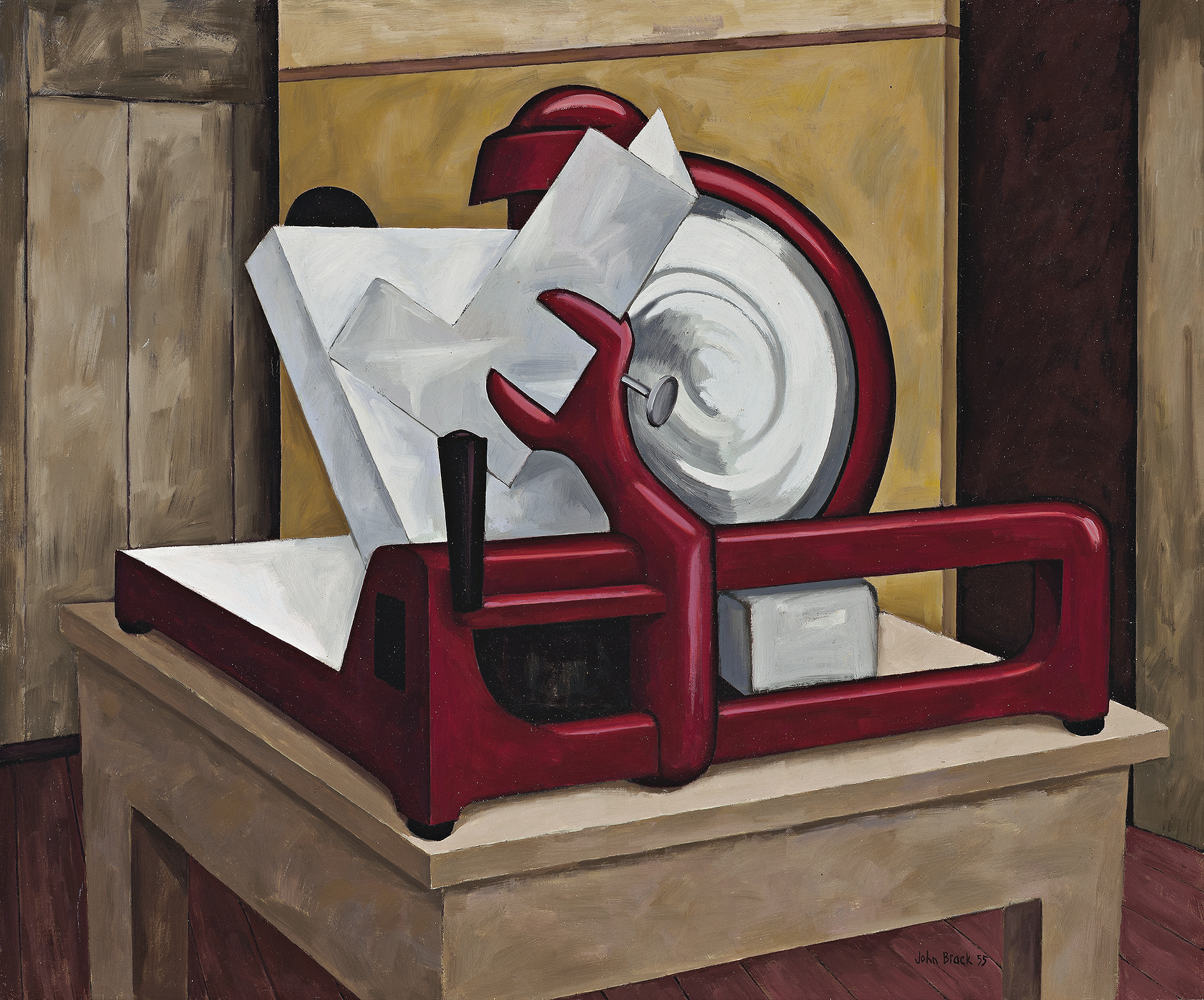
While Brack strove to create art which engaged with universal themes, his method of identifying subject matter that was close at hand inevitably resulted in images with a distinctly local flavour – recognisable to anyone who grew up in mid-twentieth century Australia, and especially in Melbourne – and unavoidable elements of autobiography appear throughout his oeuvre. The artist’s family inevitably features; his wife Helen was the model for The sewing machine, 1955, for example, and their daughters provided both the visual and thematic inspiration for paintings like The chase, 1959 (both Art Gallery of Ballarat). Similarly, The bar, 1954 (National Gallery of Victoria) – an homage of sorts, which transposes the elegant Parisian setting of Edouard Manet’s famous painting, A bar at the Folies-Bergère, 1882, to austere 1950s Melbourne – was based on Brack’s experience of the six o’clock swill in city pubs on his way home from work. Critics typically found his work funny and often characterised Brack’s approach as satirical, missing the deliberate irony and layers of allusion and symbolism that are embedded within his compositions. As the artist later said, his paintings were ‘part of a metaphorical system… intended to operate on numerous levels of meaning [and]… to have some reference to the complexity of life.’3
250182-Brack.jpg
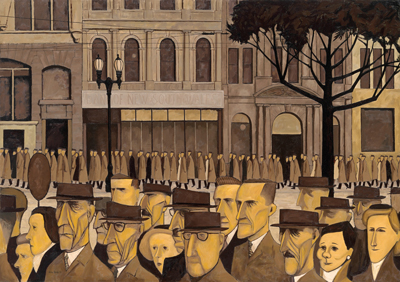
Shop window displays provided inspiration for Brack throughout his career and indeed, the experience of seeing reproductions of paintings by Van Gogh in a Little Collins Street shopfront in the late 1930s was a motivating factor in his decision to pursue a career as a professional artist. He later recalled that this vision had a powerful, physical effect, it was ‘a sort of shuddering… overwhelmingly, totally unexpected moment.’4 The most concentrated series of shop window subjects was painted in the early 1960s and the windows which featured in paintings such as Still life with self portrait, 1963 (Art Gallery of South Australia) and The happy boy, 1964 (National Gallery of Australia) displayed surgical instruments, prosthetic limbs and other medical aids. Incorporating obvious associations with the human body, these objects enabled Brack to comment about life without depicting the figure. He often found his subjects walking the city streets and would record the details of what he saw in quick sketches that were later used as aides-memoire in the studio. Additional detail was sometimes provided by photographs taken by his friend Laurence Course, an art historian and keen photographer.
250182 John Brack, The Block.jpg
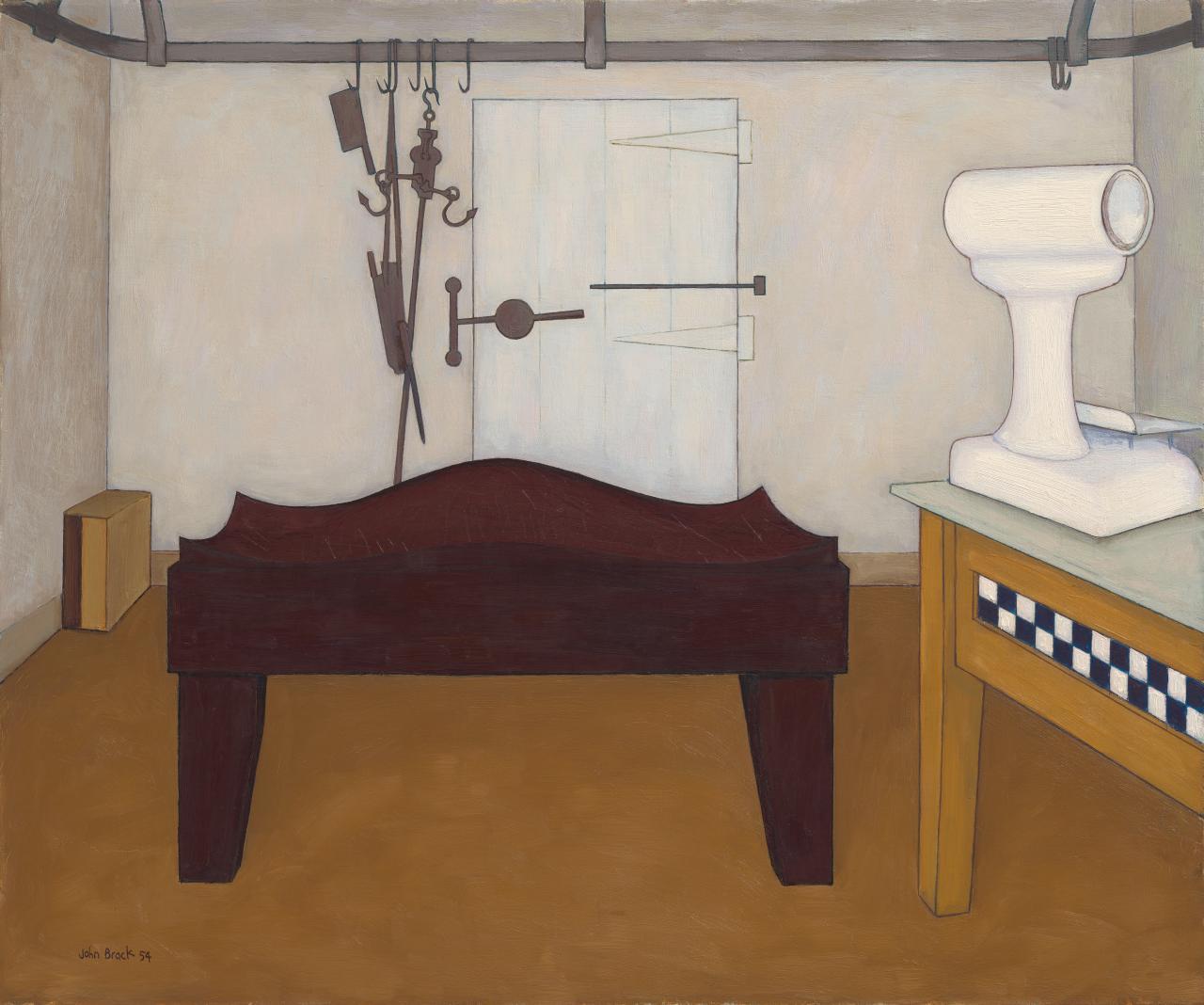
An important example of Brack’s work from a key period in his career, it reflects his distinctive visual aesthetic – as well as the aesthetic of the times – and speaks to major themes that preoccupied his oeuvre.
1. See Grant, K., ‘Human Nature: The Art of John Brack’ in Grant, K., John Brack, National Gallery of Victoria, Melbourne, 2009, p. 92
2. Brack, J., ‘Brack on Brack’, Council of Adult Education, Discussion Group Art Notes, Melbourne, ref. no. A401, 1957, p. 2
3. John Brack interview, Australian Contemporary Art Archive, no. 1, Deakin University Media Production, 1980, transcript, p. 3
4. John Brack, cited in Grishin, S., The Art of John Brack, Oxford University Press, Melbourne, 1990, p. 7
5. Brack, 1957, op. cit., p. 5
6. Grishin, op. cit., p. 51
7. Brack, 1957, op. cit.
8. McCulloch, A., ‘Co-ordination and a satirist’, Herald, Melbourne, 21 March 1956
9. ‘Painter shows originality’, Age, Melbourne, 20 March 1956
10. ibid.
KIRSTY GRANT
